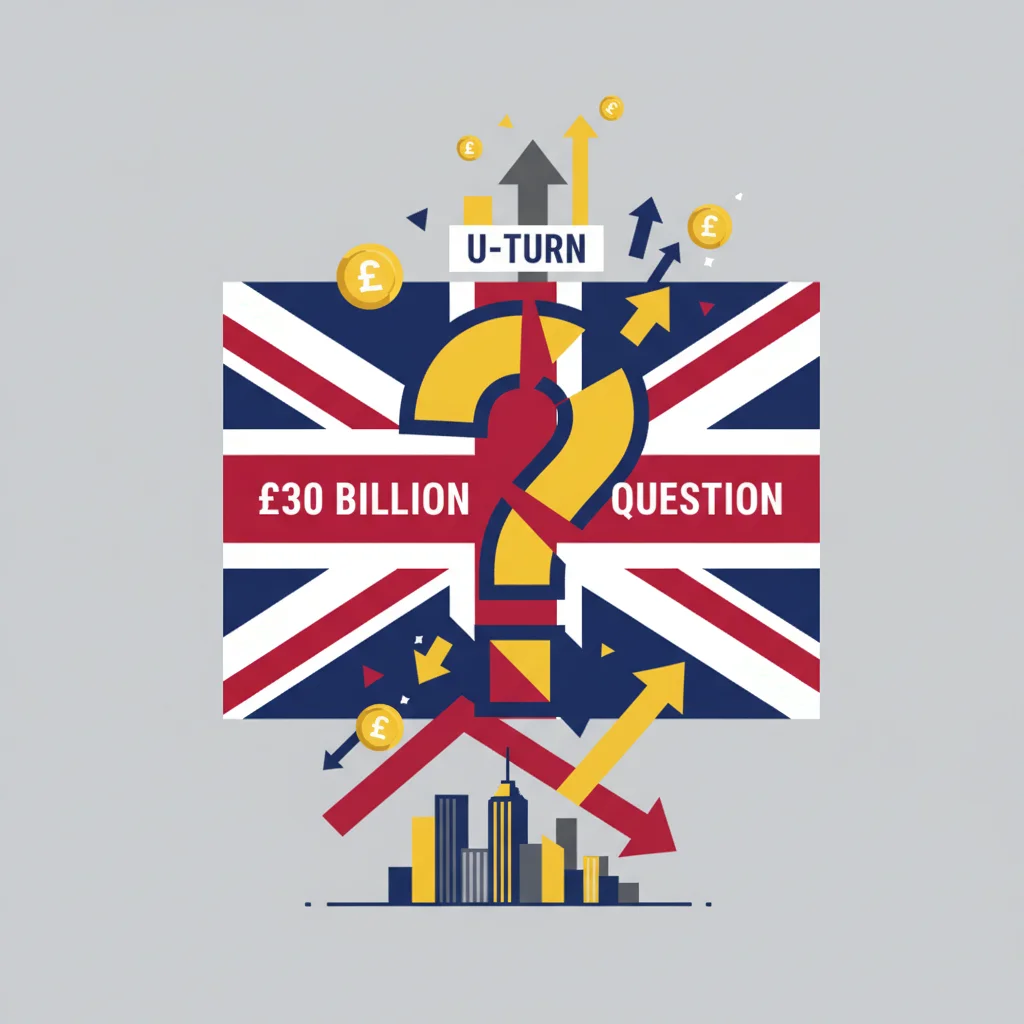
The UK’s £30 Billion Question: Why Labour’s Tax U-Turn Changes Everything for Investors
In the high-stakes world of national economics, few announcements carry as much weight as a major party’s stance on taxation. Recently, the UK’s political and financial landscape was stirred by a significant policy shift from the Labour Party. Shadow Chancellor Rachel Reeves and party leader Keir Starmer have unequivocally ruled out raising income tax rates to address the nation’s formidable fiscal challenges, a move that sends powerful signals to investors, business leaders, and the general public. This decision comes as the current government grapples with a fiscal black hole estimated to be as large as £30 billion.
This isn’t just a pre-election promise; it’s a strategic repositioning that reflects a new reality in British politics and economics. The decision to take income tax hikes off the table forces a crucial question: if not from the pockets of earners, where will the money come from to fund public services and stabilise the national debt? This blog post will delve into the implications of this pivotal decision, exploring the alternative revenue streams being considered, the potential impact on the UK economy, and what this means for your investment strategy in a climate of fiscal uncertainty.
Deconstructing the £30 Billion Fiscal Hole
Before analysing the solution, it’s essential to understand the problem. The term “fiscal hole” refers to the gap between the government’s projected spending and its expected tax revenues. This isn’t just an abstract number; it represents the real-world shortfall in funding for everything from the NHS and education to defence and infrastructure. According to analysis by leading think tanks like the Institute for Fiscal Studies, this gap has been exacerbated by a cocktail of economic pressures.
The primary drivers include:
- Slowing Economic Growth: A sluggish economy means lower-than-expected tax receipts from businesses and individuals.
- Persistent Inflation: While easing, higher inflation has driven up the cost of government debt interest payments and public sector wages.
- Rising Demand for Public Services: An ageing population and the post-pandemic backlog have placed unprecedented strain on services like the NHS, requiring significant future investment.
- Global Instability: Geopolitical events have impacted energy prices and supply chains, adding further costs and uncertainty to the UK’s economic outlook.
This confluence of factors creates a brutal reality for any incoming government: difficult choices must be made. The decision by Labour to ringfence income tax, National Insurance, and VAT from any rate increases signals a deliberate choice to look elsewhere for answers, fundamentally altering the landscape of UK public finance.
Steel Over Startups: Decoding the UK's High-Stakes Pivot in Industrial Strategy
Labour’s Strategic Pivot: Politics Meets Economics
On the surface, promising not to raise headline income tax rates is a politically astute move. It aims to neutralise a classic Conservative attack line that Labour is the party of high taxes, thereby appealing to middle-income voters and the business community. It’s a clear attempt to project an image of stability and fiscal responsibility, reassuring markets that a change in government would not lead to radical, anti-business shocks to the economy.
However, the economic rationale is more nuanced. Proponents of the move argue that raising income tax could stifle economic recovery. Higher taxes on earnings can reduce disposable income, dampen consumer spending—a key driver of the UK economy—and potentially disincentivise work and investment. By keeping income tax rates stable, the argument goes, the government can foster a more favourable environment for growth, which in turn would boost overall tax revenues in the long run.
This strategy effectively prioritises economic growth as the primary solution to fiscal consolidation. The gamble is that by creating a stable and predictable tax environment for the majority of earners, the private sector will be encouraged to invest, expand, and ultimately help grow the economy out of its fiscal predicament. This places immense pressure on the success of other pro-growth policies, from planning reform to industrial strategy.
If Not Income Tax, Then What? Exploring the Alternatives
With the biggest revenue-raising tools locked away, any government must get creative. The search for £30 billion will involve a deep dive into other areas of the tax system. Below is a breakdown of the most likely candidates for reform, each with its own set of economic and political challenges.
| Potential Revenue Source | Description & Rationale | Potential Impact on Investors & Economy |
|---|---|---|
| Capital Gains Tax (CGT) Reform | Aligning CGT rates with income tax rates. Currently, CGT is taxed at a lower rate (10%/20% for most assets, 18%/28% for property) than income. The rationale is to treat income from wealth the same as income from work. | Significant impact on the stock market and property investors. Could trigger a sell-off of assets before changes are implemented and may disincentivise long-term investing. |
| Pension Tax Relief Changes | Reducing the tax relief on pension contributions for higher earners or changing the lifetime allowance. This targets wealth accumulated in private pensions. | Directly affects high-net-worth individuals and their retirement planning. Could alter savings behaviour and the flow of funds into pension schemes. |
| “Non-Dom” Status Abolition | Scrapping the non-domiciled tax status, which allows UK residents whose permanent home is abroad to avoid paying UK tax on foreign income. This has been a long-standing Labour policy. | While politically popular, the revenue raised is debated. Risks an exodus of wealthy individuals, potentially impacting investment and high-end sectors of the economy. |
| Windfall Taxes | Imposing additional one-off taxes on sectors deemed to have made excessive profits, such as energy companies or major banks. | Can deter investment in targeted sectors. Affects share prices and dividend payouts for companies in the banking and energy industries. Creates policy uncertainty. |
| Fiscal Drag (“Stealth Taxes”) | Freezing income tax thresholds while wages rise with inflation. This silently pulls more people into higher tax brackets without changing the rates. This is a strategy already in use by the current government (source: OBR). | Reduces real-terms disposable income for millions, potentially dampening consumer spending. It’s less politically explosive than raising rates but has a real impact on household finance. |
Each of these options represents a trade-off between raising revenue, promoting economic fairness, and maintaining a pro-investment environment. The path chosen will define the UK’s economic trajectory for years to come.
Grounded Nation: How Airport Chaos Reveals Deep Fissures in the US Economy
The Future of Finance: Can Technology Offer a Solution?
While fiscal policy often focuses on traditional levers like tax rates, the rapid evolution of financial technology (fintech) presents both challenges and opportunities. Governments globally are exploring how technology can improve the efficiency of tax collection and create new economic paradigms. For instance, the UK’s “Making Tax Digital” initiative is an early example of using fintech to streamline reporting for businesses.
Looking further ahead, some economists and technologists speculate on the role of emerging technologies. The debate around Central Bank Digital Currencies (CBDCs), for example, includes discussions on how a digital pound could create more transparent and efficient payment systems. While still highly conceptual, the integration of technologies like distributed ledgers, often associated with blockchain, could one day offer novel ways to manage public finance. These are not short-term solutions to a £30 billion hole, but they represent a technological undercurrent that will undoubtedly shape the future of economics and government revenue.
Actionable Takeaways for Investors and Business Leaders
Labour’s policy shift creates a new set of variables for strategic planning. The immediate takeaway is a reduced risk of broad-based income tax hikes, which can be seen as a positive for consumer-facing sectors and the general stock market. However, the risk has not vanished; it has merely been transferred to other areas.
- Review Your Portfolio’s Tax Exposure: The spotlight will now turn to capital gains and dividend income. Investors should work with financial advisors to understand their potential CGT liability and consider tax-efficient wrappers like ISAs and pensions.
- Anticipate Sector-Specific Risk: Businesses and investors in the energy, banking, and private equity sectors should brace for heightened scrutiny and the potential for targeted levies or regulatory changes.
- Focus on Long-Term Growth: The overarching goal of any future government will be to stimulate economic growth. Companies that are well-positioned to benefit from a pro-growth agenda—such as those in technology, renewable energy, and advanced manufacturing—may present attractive long-term investing opportunities.
Ultimately, the decision to hold fire on income tax is the opening move in a complex chess game over the future of the UK economy. While it provides a degree of certainty, it also opens up a new front of uncertainty regarding wealth and corporate taxation. The £30 billion question remains unanswered, and for those navigating the worlds of finance and investment, staying informed and agile will be more critical than ever. The next government’s first budget will be the moment of truth, revealing the true cost of this pivotal promise.
The Billion Deal That Vanished: How Geopolitics Just Redrew the Map for Global Finance


